Abstract
The progress toward single-dose vaccines has been limited by the poor solid-state stability of vaccine antigens within controlled-release polymers, such as poly(lactide-co-glycolide). For example, herein we report that lyophilized tetanus toxoid aggregates during incubation at 37 degrees C and elevated humidity--i.e., conditions relevant to its release from such systems. The mechanism and extent of this aggregation are dependent on the moisture level in the solid protein, with maximum aggregation observed at intermediate moisture contents. The main aggregation pathway is consistent with formaldehyde-mediated cross-linking, where reactive electrophiles created and stored in the vaccine upon formalinization (exposure to formaldehyde during vaccine preparation) react with nucleophiles of a second vaccine molecule to form intermolecular cross-links. This process is inhibited by the following: (i) succinylating the vaccine to block reactive amino groups; (ii) treating the vaccine with sodium cyanoborohydride, which presumably reduces Schiff bases and some other electrophiles created upon formalinization; and (iii) addition of low-molecular-weight excipients, particularly sorbitol. The moisture-induced aggregation of another formalinized vaccine, diphtheria toxoid, is also retarded by succinylation, suggesting the generality of this mechanism for formalinized vaccines. Hence, mechanistic stability studies of the type described herein may be important for the development of effective single-dose vaccines.
Full text
PDF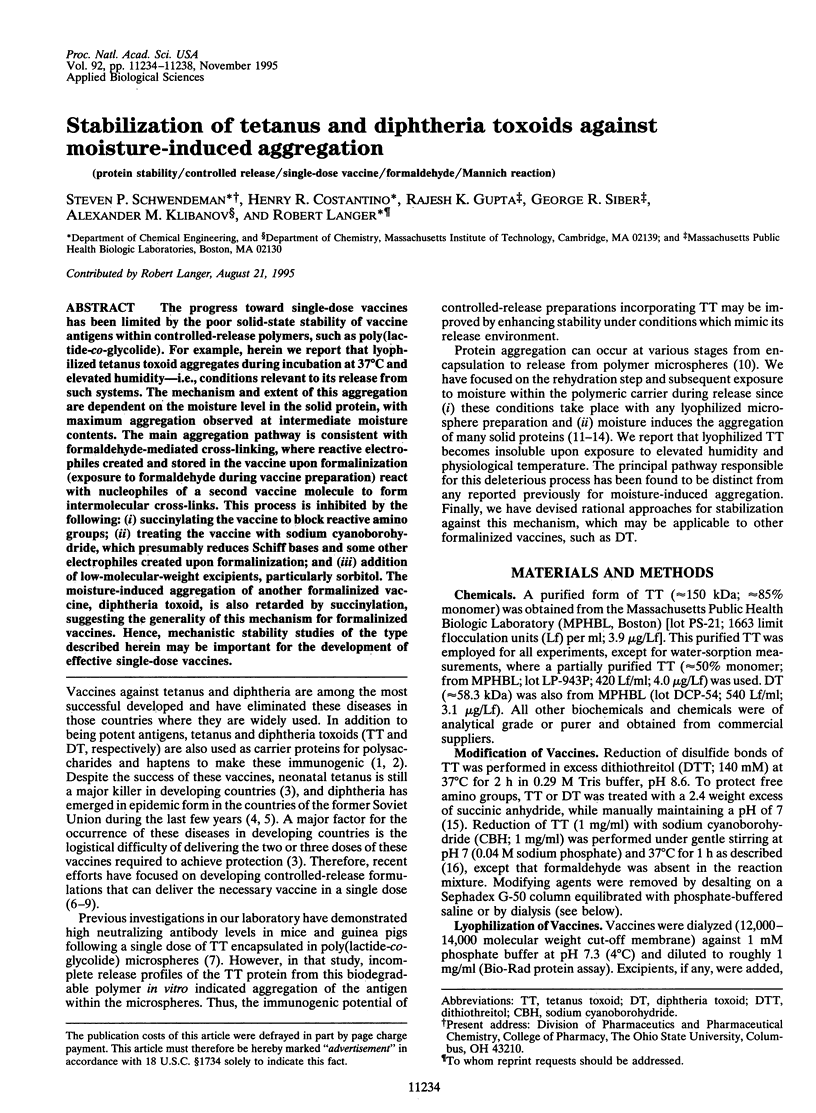
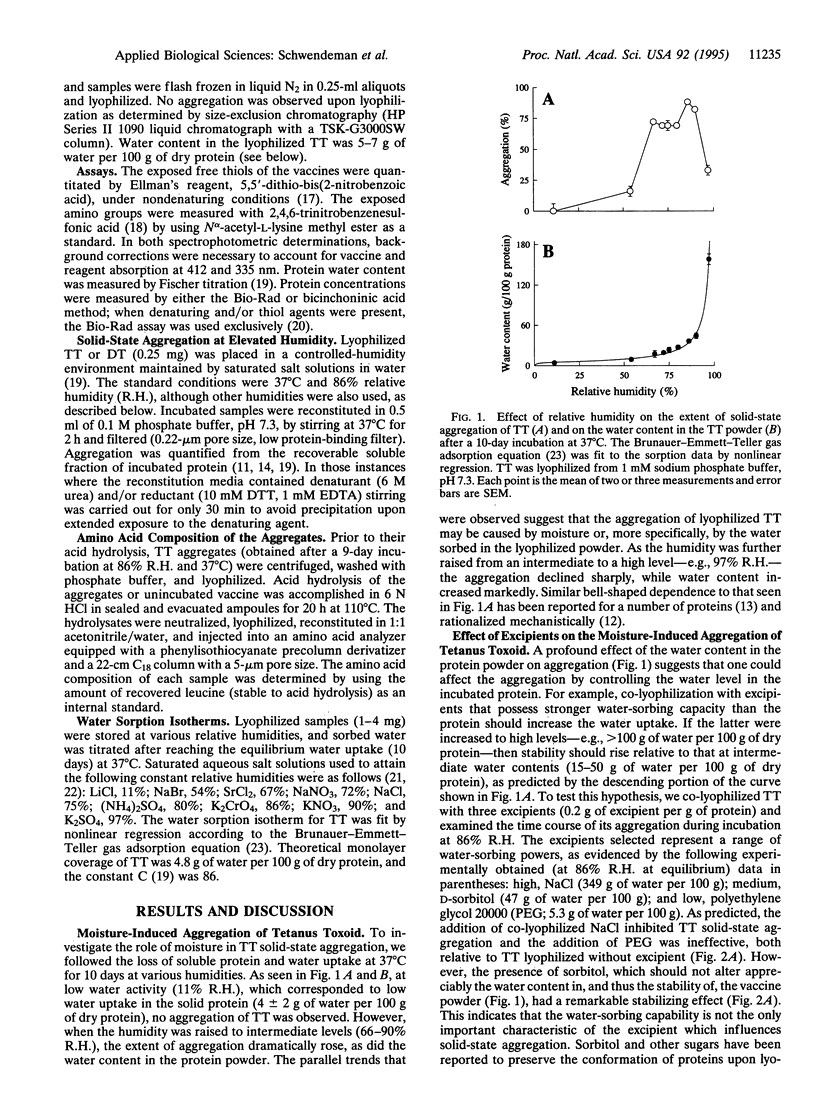
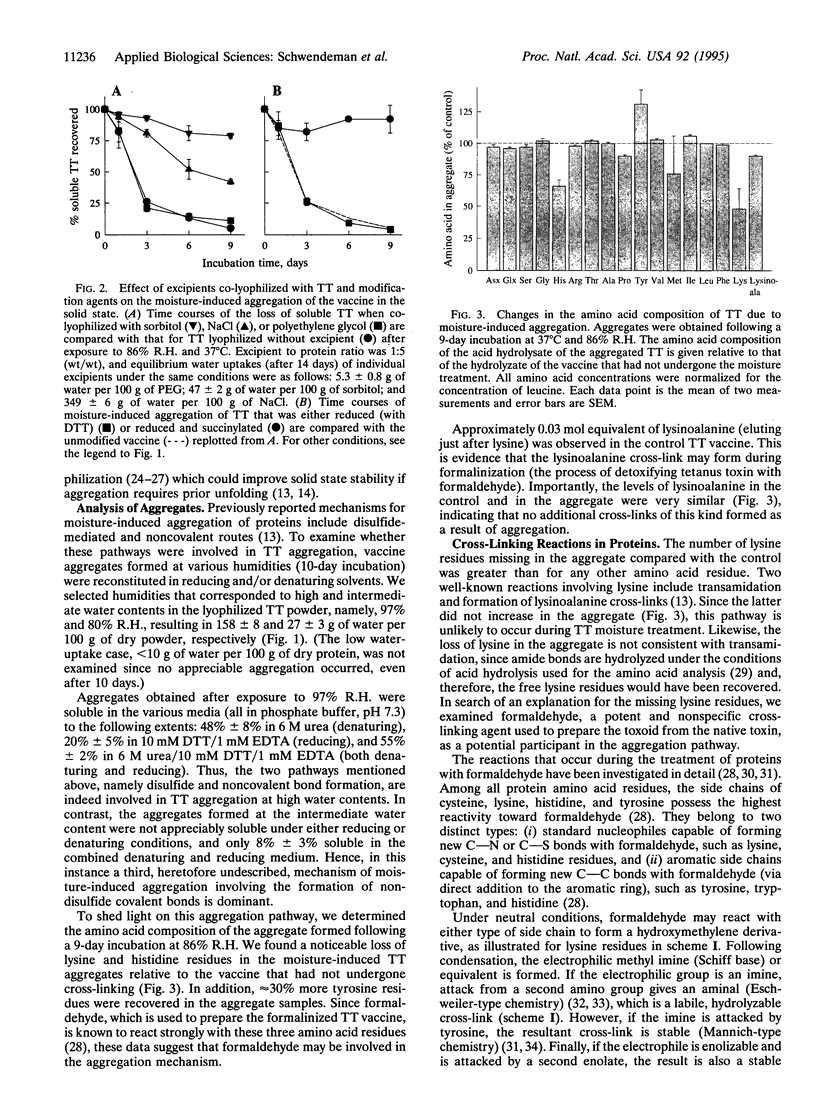
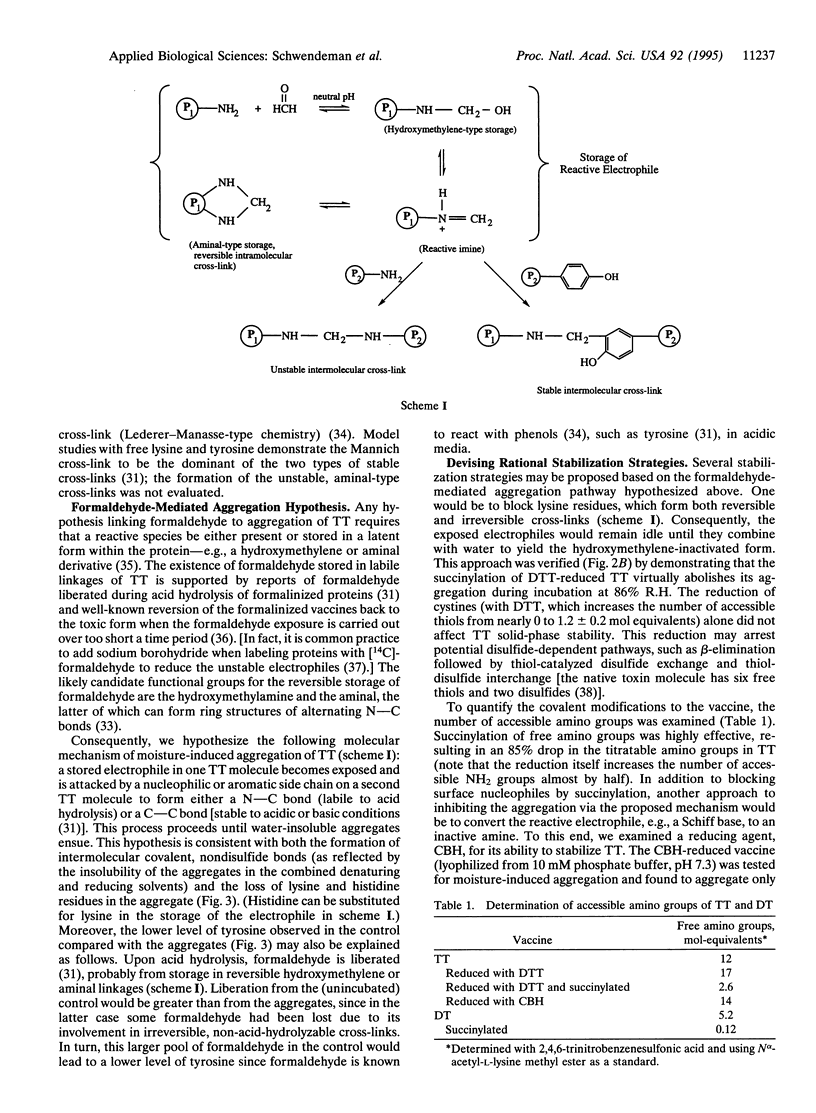
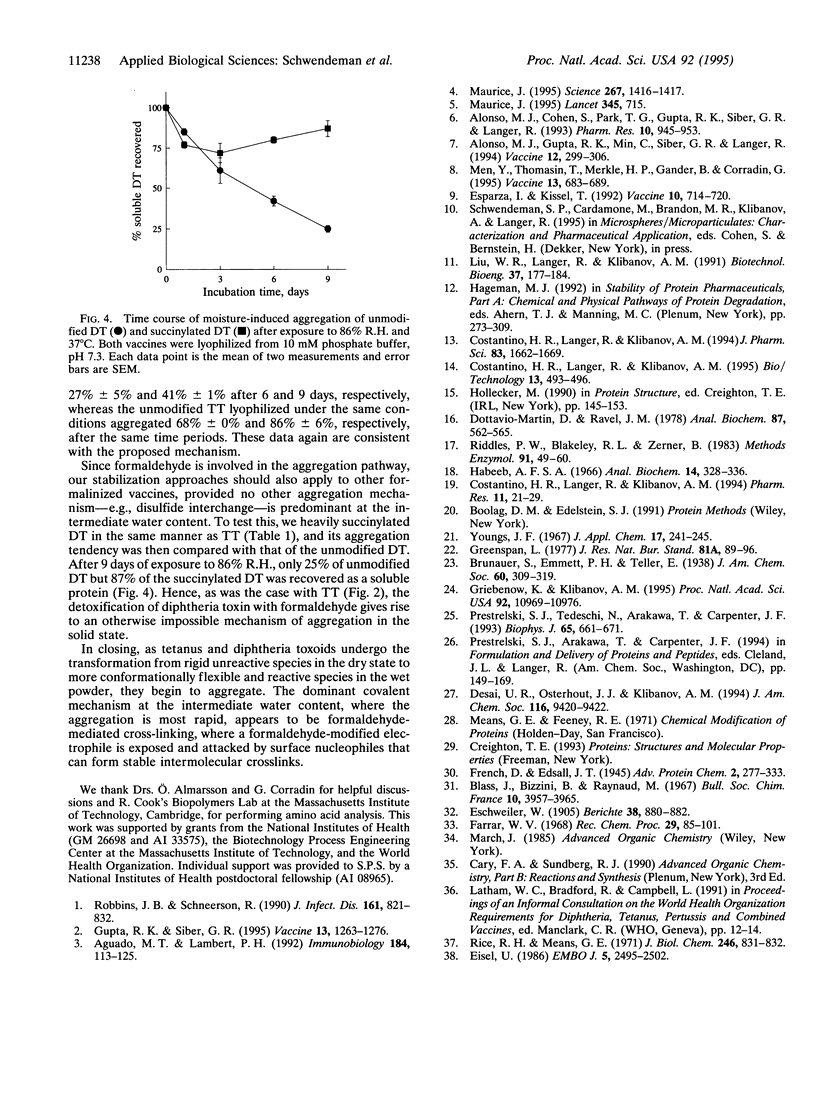
Images in this article
Selected References
These references are in PubMed. This may not be the complete list of references from this article.
- Aguado M. T., Lambert P. H. Controlled-release vaccines--biodegradable polylactide/polyglycolide (PL/PG) microspheres as antigen vehicles. Immunobiology. 1992 Feb;184(2-3):113–125. doi: 10.1016/S0171-2985(11)80470-5. [DOI] [PubMed] [Google Scholar]
- Alonso M. J., Cohen S., Park T. G., Gupta R. K., Siber G. R., Langer R. Determinants of release rate of tetanus vaccine from polyester microspheres. Pharm Res. 1993 Jul;10(7):945–953. doi: 10.1023/a:1018942118148. [DOI] [PubMed] [Google Scholar]
- Alonso M. J., Gupta R. K., Min C., Siber G. R., Langer R. Biodegradable microspheres as controlled-release tetanus toxoid delivery systems. Vaccine. 1994 Mar;12(4):299–306. doi: 10.1016/0264-410x(94)90092-2. [DOI] [PubMed] [Google Scholar]
- Costantino H. R., Langer R., Klibanov A. M. Aggregation of a lyophilized pharmaceutical protein, recombinant human albumin: effect of moisture and stabilization by excipients. Biotechnology (N Y) 1995 May;13(5):493–496. doi: 10.1038/nbt0595-493. [DOI] [PubMed] [Google Scholar]
- Costantino H. R., Langer R., Klibanov A. M. Moisture-induced aggregation of lyophilized insulin. Pharm Res. 1994 Jan;11(1):21–29. doi: 10.1023/a:1018981208076. [DOI] [PubMed] [Google Scholar]
- Costantino H. R., Langer R., Klibanov A. M. Solid-phase aggregation of proteins under pharmaceutically relevant conditions. J Pharm Sci. 1994 Dec;83(12):1662–1669. doi: 10.1002/jps.2600831205. [DOI] [PubMed] [Google Scholar]
- Dottavio-Martin D., Ravel J. M. Radiolabeling of proteins by reductive alkylation with [14C]formaldehyde and sodium cyanoborohydride. Anal Biochem. 1978 Jul 1;87(2):562–565. doi: 10.1016/0003-2697(78)90706-6. [DOI] [PubMed] [Google Scholar]
- Eisel U., Jarausch W., Goretzki K., Henschen A., Engels J., Weller U., Hudel M., Habermann E., Niemann H. Tetanus toxin: primary structure, expression in E. coli, and homology with botulinum toxins. EMBO J. 1986 Oct;5(10):2495–2502. doi: 10.1002/j.1460-2075.1986.tb04527.x. [DOI] [PMC free article] [PubMed] [Google Scholar]
- Esparza I., Kissel T. Parameters affecting the immunogenicity of microencapsulated tetanus toxoid. Vaccine. 1992;10(10):714–720. doi: 10.1016/0264-410x(92)90094-z. [DOI] [PubMed] [Google Scholar]
- Griebenow K., Klibanov A. M. Lyophilization-induced reversible changes in the secondary structure of proteins. Proc Natl Acad Sci U S A. 1995 Nov 21;92(24):10969–10976. doi: 10.1073/pnas.92.24.10969. [DOI] [PMC free article] [PubMed] [Google Scholar]
- Gupta R. K., Siber G. R. Adjuvants for human vaccines--current status, problems and future prospects. Vaccine. 1995 Oct;13(14):1263–1276. doi: 10.1016/0264-410x(95)00011-o. [DOI] [PubMed] [Google Scholar]
- Habeeb A. F. Determination of free amino groups in proteins by trinitrobenzenesulfonic acid. Anal Biochem. 1966 Mar;14(3):328–336. doi: 10.1016/0003-2697(66)90275-2. [DOI] [PubMed] [Google Scholar]
- Liu W. R., Langer R., Klibanov A. M. Moisture-induced aggregation of lyophilized proteins in the solid state. Biotechnol Bioeng. 1991 Jan 20;37(2):177–184. doi: 10.1002/bit.260370210. [DOI] [PubMed] [Google Scholar]
- Maurice J. Russian chaos breeds diphtheria outbreak. Science. 1995 Mar 10;267(5203):1416–1417. doi: 10.1126/science.7878458. [DOI] [PubMed] [Google Scholar]
- Men Y., Thomasin C., Merkle H. P., Gander B., Corradin G. A single administration of tetanus toxoid in biodegradable microspheres elicits T cell and antibody responses similar or superior to those obtained with aluminum hydroxide. Vaccine. 1995 May;13(7):683–689. doi: 10.1016/0264-410x(94)00046-p. [DOI] [PubMed] [Google Scholar]
- Prestrelski S. J., Tedeschi N., Arakawa T., Carpenter J. F. Dehydration-induced conformational transitions in proteins and their inhibition by stabilizers. Biophys J. 1993 Aug;65(2):661–671. doi: 10.1016/S0006-3495(93)81120-2. [DOI] [PMC free article] [PubMed] [Google Scholar]
- Rice R. H., Means G. E. Radioactive labeling of proteins in vitro. J Biol Chem. 1971 Feb 10;246(3):831–832. [PubMed] [Google Scholar]
- Riddles P. W., Blakeley R. L., Zerner B. Reassessment of Ellman's reagent. Methods Enzymol. 1983;91:49–60. doi: 10.1016/s0076-6879(83)91010-8. [DOI] [PubMed] [Google Scholar]
- Robbins J. B., Schneerson R. Polysaccharide-protein conjugates: a new generation of vaccines. J Infect Dis. 1990 May;161(5):821–832. doi: 10.1093/infdis/161.5.821. [DOI] [PubMed] [Google Scholar]



